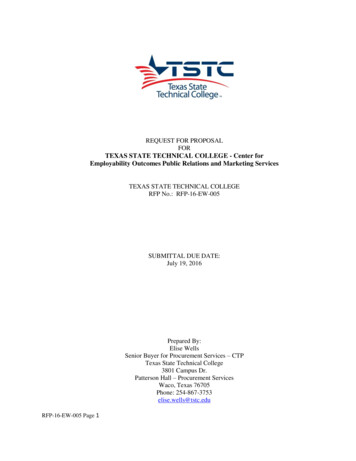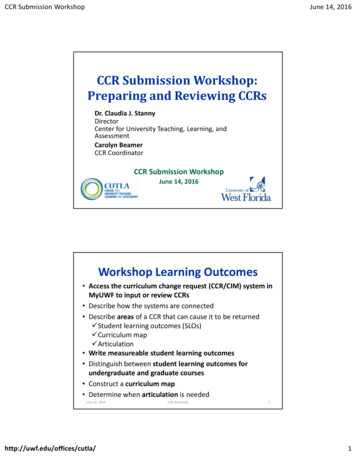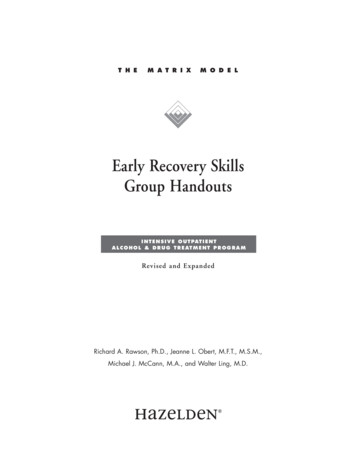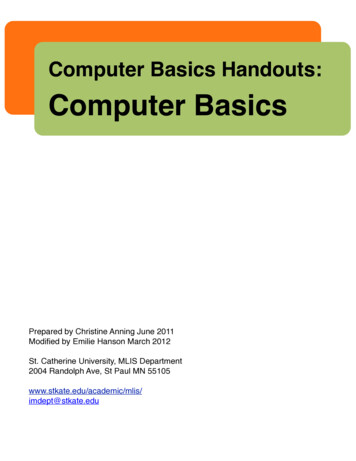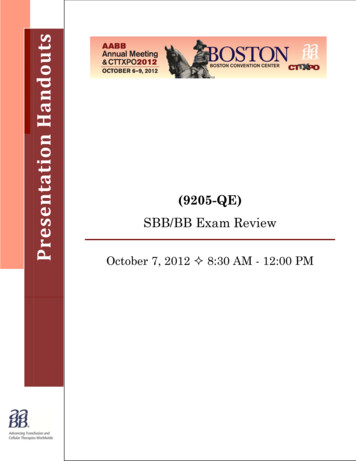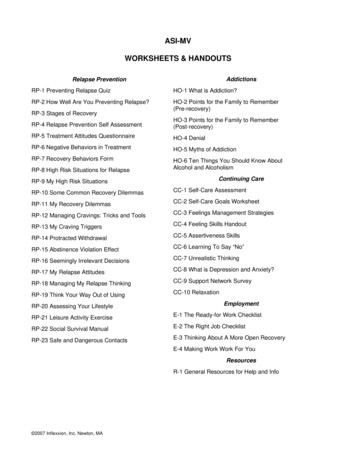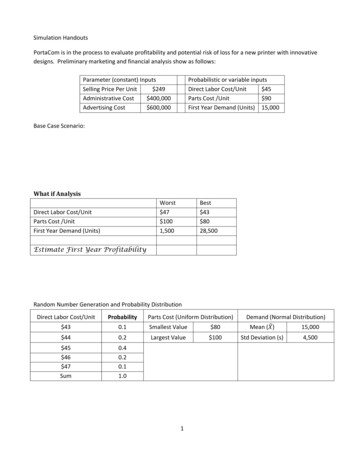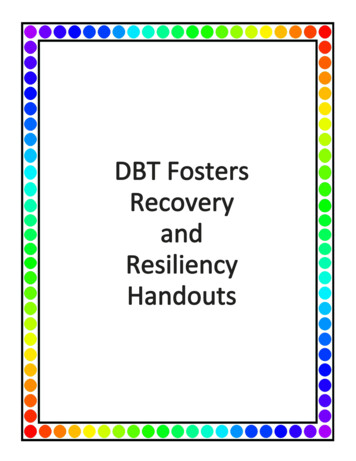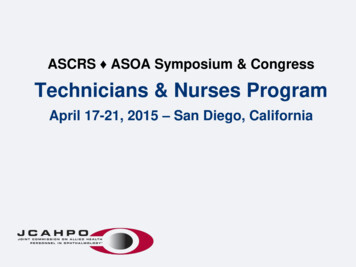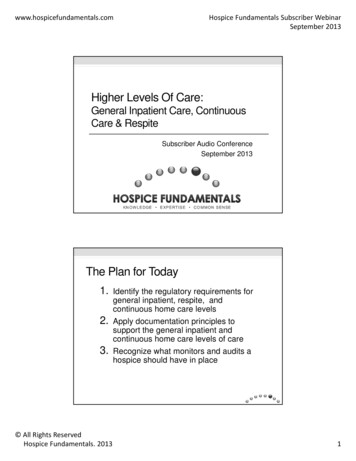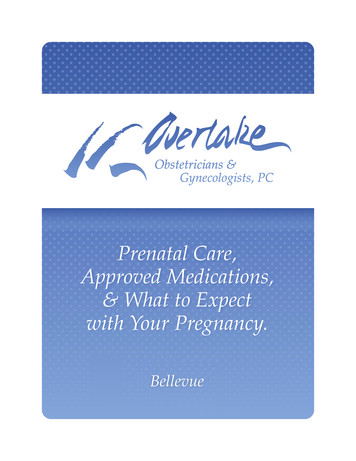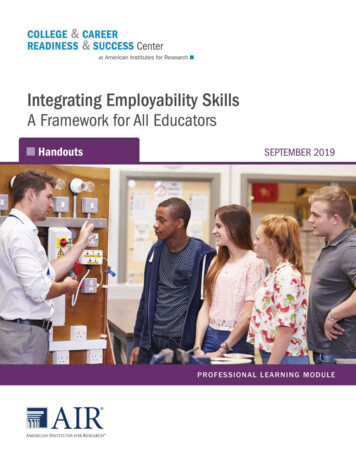
Transcription
COLLEGE & CAREERREADINESS & SUCCESS Centerat American Institutes for ResearchIntegrating Employability SkillsA Framework for All EducatorsHandoutsSEPTEMBER 2019PROFESSIONAL LEARNING MODULE
About This BookletThis Integrating Employability Skills: A Framework for All Educators Handouts booklet is intended foruse with the following additional resources: Integrating Employability Skills: A Framework for All Educators Facilitator’s Guide Integrating Employability Skills: A Framework for All Educators sample agenda Integrating Employability Skills: A Framework for All Educators slide presentation Integrating Employability Skills: A Framework for All Educators WorkbookAdapting This BookletThis booklet is designed so that facilitators can adopt it as written or modify the content toreflect state and local contexts, needs, and priorities. If modifications to content are made, the CCRSCenter requests that the following disclaimer be included in the revised materials:This booklet was modified in whole or in part with permission from the College and CareerReadiness and Success Center.
Integrating Employability Skills:A Framework for All Educators HandoutsApril 2016 (Updated September 2019)College and Career Readiness and Success Center1000 Thomas Jefferson Street NWWashington, DC 20007-3835800-634-0503www.ccrscenter.orgCopyright 2019 American Institutes for Research. All rights reserved.This work was originally produced in whole or in part by the College and Career Readiness and Success Center with funds from the U.S. Department ofEducation under cooperative agreement number S283B120034. The content does not necessarily reflect the position or policy of the Department ofEducation, nor does mention or visual representation of trade names, commercial products, or organizations imply endorsement by the federal government.Copyright 2019 American Institutes for Research. All rights reserved.www.air.org9501 09/19
ContentsHandout A. What Are Employability Skills?. 1Handout B. Employability Skills Framework: Definitions . 2Handout C. Curriculum Planning Tool to Integrate Employability Skills . 6Handout D. Employability Skill and Instruction Matching Activity . 7Handout E. Formative Lesson Planning Tool: Integrating Employability Skills Into Instruction . 18Handout F. Formative Lesson Planning Tool for Integrating Employability Skills Into Practice(Career and Technical Education [CTE] Sample) . 19Handout G. Formative Lesson Planning Tool for Integrating Employability Skills Into Practice(English Language Arts [ELA] Activity Template) . 23Handout H. Formative Lesson Planning Tool for Integrating Employability Skills Into Practice(English Language Arts [ELA] Sample) . 27Handout I. Summative Lesson Planning Self-Reflection Tool . 31Handout J. Scenarios for Business—Employability Skills . 39
Handout A. What Are Employability Skills?Part IWrite out the top 5–10 employability skills you consider to be most important:1.6.2.7.3.8.4.9.5.10.Part IIPlace the employability skills listed above into the following three categories of skills:Effective RelationshipsWorkplace SkillsApplied KnowledgeRecategorized SkillsCCRS CenterIntegrating Employability Skills: A Framework for All Educators Handouts—1
Handout B. Employability Skills Framework:DefinitionsNote: The content of this handout is adapted from the Employability Skills Framework loyability skills are general skills that are necessary for success in the labor market at allemployment levels and in all sectors.These skills, which may be taught through the education and workforce development systems,fall into three broad categories: Effective Relationships—The interpersonal skills and personal qualities that enableindividuals to interact effectively with clients, coworkers, and supervisors Workplace Skills—The analytical and organizational skills and understandings thatemployees need to successfully perform work tasks Applied Knowledge—The thoughtful integration of academic knowledge and technicalskills, put to practical use in the workplaceWithin each of these three categories, there are nine sets of skills, detailed on the following pages.Effective RelationshipsInterpersonal SkillsPersonal QualitiesWorkplace SkillsResource ManagementInformation UseCommunication SkillsSystems ThinkingTechnology UseApplied KnowledgeApplied Academic SkillsCritical Thinking SkillsCCRS CenterIntegrating Employability Skills: A Framework for All Educators Handouts—2
Effective RelationshipsInterpersonal SkillsInterpersonal skills enable employees to collaborate as a member of a team or workindependently, as appropriate, and contribute to the overarching goals of the workplace. Theyinclude the following: Understands teamwork and works with others Responds to customer needs Exercises leadership Negotiates to resolve conflicts Respects individual differencesPersonal QualitiesPersonal qualities include a set of behaviors and skills that enable employees to establisheffective relationships and function appropriately in the workplace. They include the following: Demonstrates responsibility and self-discipline Adapts and shows flexibility Works independently Demonstrates a willingness to learn Demonstrates integrity Demonstrates professionalism Takes initiative Displays positive attitude and sense of self-worth Takes responsibility for professional growthWorkplace SkillsResource ManagementResource management skills enable employees to perform work tasks successfully by managingtime and other resources. They include the following: Manages time Manages money Manages materials Manages personnelCCRS CenterIntegrating Employability Skills: A Framework for All Educators Handouts—3
Information UseInformation use skills enable employees to perform work tasks successfully by understanding,evaluating, and using a variety of information. They include the following: Locates information Organizes information Uses information Analyzes information Communicates informationCommunication SkillsCommunication skills enable employees to perform work tasks successfully by communicatingeffectively with others in multiple formats. They include the following: Communicates verbally Listens actively Comprehends written material Conveys information in writing Observes carefullySystems ThinkingSystems thinking skills enable employees to perform work tasks successfully by understandingrelationships among the components of a system. They include the following: Understands and uses systems Monitors systems Improves systemsTechnology UseTechnology use skills enable employees to perform work tasks successfully by applyinginformation technology appropriately and effectively. They include the following: Understands and uses technologyCCRS CenterIntegrating Employability Skills: A Framework for All Educators Handouts—4
Applied KnowledgeApplied Academic SkillsApplied academic skills enable employees to put skills based on academic disciplines andlearning—such as reading, writing, mathematical strategies and procedures, and scientificprinciples and procedures—to practical use in the workplace. They include the following: Uses reading skills Uses writing skills Uses mathematical strategies and procedures Uses scientific principles and proceduresCritical Thinking SkillsCritical thinking skills enable employees to think critically and creatively in the context of theirwork, solve work-based problems, and make sound decisions at work. They include thefollowing: Thinks critically Thinks creatively Makes sound decisions Solves problems Reasons Plans and organizesCCRS CenterIntegrating Employability Skills: A Framework for All Educators Handouts—5
Handout C. Curriculum Planning Tool to Integrate fic Knowledge, Skills, andPracticesOpportunities to Align to EmployabilitySkillsStrategies to AssessWhat actions, habits, or practices dostudents need to demonstrate in order to beproficient in this standard(s) for the unit?Which employability skills could explicitlyand implicitly connect to the standards forthis unit?What are some possiblestrategies or ways toassess these skills?ExplicitImplicitNext Steps: What Are One or Two Concrete Next Steps to Make Sure That Courses/Grade Levels Are Aligned to the EmployabilitySkills to Ensure That Students Are College and Career Ready?CCRS CenterIntegrating Employability Skills: A Framework for All Educators Handouts—6
Handout D. Employability Skill and Instruction Matching Activity1. Read the employability skills, skill components, and accompanying attributes in the tables below.2. Review the sample instructional techniques at the end of this document.3. Identify up to three sample instructional techniques that support each employability skill component. (Note: Each instructionaltechnique may support more than one employability skill.)4. Brainstorm additional instructional techniques that support the development of specific employability skills on your own orwith your colleagues.5. Write the instructional techniques in the tables below next to the employability skill components they support.6. Discuss your list with your colleagues, considering the following questions: Are these instructional techniques commonly used in schools or classrooms in your state or district? Are there notable similarities or differences among these instructional techniques (e.g., student-led, long-term, discussionbased)? Are the resources, materials, or staff needed to implement these instructional techniques available and accessible? Are teachers generally knowledgeable and able to implement these instructional techniques? Are students generally prepared and able to engage in these types of learning activities? Do students need additional socialemotional or academic support to engage in these types of learning activities?CCRS CenterIntegrating Employability Skills: A Framework for All Educators Handouts—7
Applied Academic SkillsSkillComponentsReading skillsWriting skillsInstructional Techniques That Support the Developmentof These Skill ComponentsSkill Attributes Interpret written instructions or project directionsInterpret technical languageUse print and online materials as resourcesSeek clarification about what they have read1.2.3. Construct lab reports, posters, and presentation materials Take notes Compose essay responses1.2.3.Mathematicsstrategies andprocedures Use computational skills appropriately in real-worldcontexts Make logical choices when analyzing and differentiatingamong available procedures1.Scientificprinciples andprocedures Follow procedures Experiment Infer and hypothesize (even as simple as “what if we do itthis way?”) Construct processes to complete a task1.CCRS Center2.3.2.3.Integrating Employability Skills: A Framework for All Educators Handouts—8
Critical Thinking llyMakes sounddecisionsInstructional Techniques That Support the Developmentof These Skill ComponentsSkill Attributes Create and share innovative and novel ideas in writingbased or project-based learning Create and share innovative and novel solutions to problems Display divergent thinking in project design and planning1.2.3.Display analytical and strategic thinkingDebate an issueConverge on an understandingAssess a problemQuestion (e.g., play devil’s advocate)1. Differentiate among multiple approaches Assess options1. 2.3.2.3.SolvesproblemsReasons Assess problems involving the use of available resources(i.e., personnel and materials) Review multiple strategies for resolving problems1. Negotiate pros and cons of ideas, approaches, and solutions Analyze options using “if-then” rationale1.2.3.2.3.Plans andorganizesCCRS Center Identify approaches for addressing tasksPlan steps and proceduresSolve discrete problemsComplete a long-term or multistep project1.2.3.Integrating Employability Skills: A Framework for All Educators Handouts—9
Interpersonal SkillsSkillComponentsInstructional Techniques That Support the Development ofThese Skill ComponentsSkill AttributesUnderstandsteamworkand workswith others Participate in cooperative groupsWork with a partnerContribute fairly to the taskShow respect to othersResponds tocustomerneeds Help fellow students understand tasks Find resources Fulfill assigned roles (e.g., by thinking of fellow studentsas customers)Exercisesleadership Participate as team leaders or effective team members inproject assignments Organize work and utilize team roles to meet projectgoals1.2.3.Negotiates toresolveconflict Respectsindividualdifferences Listen to and consider all team members’ ideas Respond supportively to ideas given in class or in teams Use proactive approaches to prevent conflict ormisunderstanding Work well with all teammatesCCRS CenterKeep fellow team members on trackSuggest alternative approaches or solutionsDiscuss optionsPromote or seek agreement1.2.3.1.2.3.1.2.3.1.2.3.Integrating Employability Skills: A Framework for All Educators Handouts—10
Personal QualitiesSkill ComponentsInstructional Techniques That Support the Developmentof These Skill ComponentsSkill Attributes1.Demonstratesresponsibility andself-discipline Adapts and showsflexibility Adapt easily to different modes of instruction anddifferent types of assignments Compromise with others Accept changes or modificationsWorks independentlyDemonstrates awillingness to ismCCRS CenterActively participate in classAsk questionsVolunteer answersComplete and submit assignmentsWork well in groups2.3. Commit to time-on-task during class Begin work without hesitation Plan and pace work schedule2.3.1.2.3. Cooperate and be noticeably engaged Communicate with peers and superiors with respectand confidence Share information and feedback clearly andaccurately Treat work assignments with respect in that work iseither original or credited correctly Acknowledge team members’ work or contributions Treat others with respect Consider all ideas Use appropriate dress, tone, and manners1.1.2.3.1.2.3.1.2.3.Integrating Employability Skills: A Framework for All Educators Handouts—11
Skill ComponentsTakes initiativeInstructional Techniques That Support the Developmentof These Skill ComponentsSkill Attributes Seek out and seize the opportunity to take on aleadership role on tasks and projects1.2.3.Displays a positiveattitude and sense ofself-worth Contribute new ideas or thinking to class tasks,projects, or discussions Show pride in work and strive for quality1.Takes responsibilityfor professionalgrowth Be active listeners Seek clarification and understanding when needed Accept and use feedback for improvement1.CCRS Center2.3.2.3.Integrating Employability Skills: A Framework for All Educators Handouts—12
Resource ManagementSkill ComponentsManages timeManages moneyInstructional Techniques That Support the Developmentof These Skill ComponentsSkill Attributes Demonstrate time management when organizing andplanning project activities with a team Demonstrate time management when organizing andmanaging individual class assignments andhomework1. Manage money in group projects requiring allocationof limited finances and resources1.2.3.2.3.Manages resources Manage resources in projects requiring allocation oflimited resources and personnel1.2.3.Manages personnelCCRS Center Gain experience managing personnel (i.e., each other)in group projects requiring role assignments Manage their own behavior and participation1.2.3.Integrating Employability Skills: A Framework for All Educators Handouts—13
Information UseSkill ComponentsLocatesOrganizesUsesInstructional Techniques That Support the Developmentof These Skill ComponentsSkill Attributes Use analytical strategies to determine the bestmedium for finding necessary information Differentiate among data sources1. Use any graphic organizer (e.g., outline, conceptmap, organizational chart, or table) to sortinformation or data1. Use classification and analytic skills to determine thenecessary information to complete a task1.2.3.2.3.2.3.AnalyzesCommunicates Assess information to determine which is relevant Understand the relationship between different piecesof information1. Summarize information in oral or written form Explain information, reasoning, or process1.2.3.2.3.CCRS CenterIntegrating Employability Skills: A Framework for All Educators Handouts—14
Communication SkillsSkill ComponentsCommunicatesverballyInstructional Techniques That Support the Developmentof These Skill ComponentsSkill Attributes Provide oral responses to impromptu short questions Share ideas or feedback with peers or teachers Complete a formal oral presentation1.2.3. Be noticeably engaged through note-taking,questioning, and responding Respond well to constructive feedback Adapt accordingly1. Follow written instructions or project directions Review print and digital resources Ask questions about what they have read1.Conveysinformation inwriting Organize lab reports, posters, and presentationmaterials Take notes1.Observes carefully Interpret the verbal and nonverbal communicationefforts of others Follow and take directions from teachers or peers1.Listens activelyComprehendswritten materialCCRS Center2.3.2.3.2.3.2.3.Integrating Employability Skills: A Framework for All Educators Handouts—15
Systems ThinkingSkillComponentsUnderstands anduses systemsMonitors systemsInstructional Techniques That Support the Developmentof These Skill ComponentsSkill Attributes Understand their roles and assignments whencollaborating as a team (e.g., system) Contribute to the organizational structure and functionof the team Identify resources (people or information) that canfurther project aims1.3. Devise methods to assess team (e.g., system) progress1.2.2.3.Improves systems Negotiate midcourse corrections and adaptations to team(e.g., system) tasks if necessary1.2.3.Technology UseSkillComponentsUnderstands anduses technologyCCRS CenterInstructional Techniques That Support the Developmentof These Skill ComponentsSkill Attributes Use appropriate digital technologies for calculating,collecting and displaying data, conducting research,creating presentations, and writing reports Identify attributes and uses of common digitaltechnologies1.2.3.Integrating Employability Skills: A Framework for All Educators Handouts—16
Sample Instructional Techniquesa. Socratic seminarb. Peer feedback on written work or completed projectc. Group project with online document-sharing softwared. Group projects with group member titles (i.e., treasurer, project manager)e. Multimedia presentation with video, audio, and presentation softwaref. Physical project (i.e., bridge made of popsicle sticks) built outside of class with a limited budget and resourcesg. Scenario-based learning where students respond to new challenges or information in real-time while completing a taskh. “Turn and Talk”i. Written research projectsj. Student polling and discussion of resultsk. Student presentations and feedback on project progressl. Facilitated group discussions with open-ended questionsm. “Notice and Wonder”n. Student-run store or business ventureCCRS CenterIntegrating Employability Skills: A Framework for All Educators Handouts—17
Handout E. Formative Lesson Planning Tool: IntegratingEmployability Skills Into InstructionCourse TypeLesson TitleLesson DurationDescription of Lesson ActivitiesOutcomes or StandardsWhat do you want students to learn orexperience in the course?Teacher-Led ElementsWhat do you do during class to guide studentlearning?Student-Led ElementsWhat do students do? How will they interactwith each other?Identify Employability Skills (Check all that apply.) Interpersonal Skills Information Use Technology Use Personal Qualities Communication Skills Applied Academic Skills Resource Management Systems Thinking Critical Thinking SkillsCCRS CenterIntegrating Employability Skills: A Framework for All Educators Handouts—18
Handout F. Formative Lesson Planning Tool for IntegratingEmployability Skills Into Practice (Career and Technical Education[CTE] Sample)10th-Grade Culinary Arts CourseLesson: Food PreservationThree Days or Class Periods Plus Extended Learning ProjectsObjectives Students will learn about the role of safely managing bacteria in food, including common preservation techniques andsanitation practices. Students will analyze and synthesize multiple data points to describe how to maximize food safety over time with and withoutrefrigeration. Students will work independently and take responsibility for their own learning.Lesson ProgressionDay 1 Assess students’ prior knowledge Lecture on bacterial growth Collaborative student work: Students create presentations on assigned vocabulary terms.Days 2–3 Student presentations of vocabulary terms Bacterial growth lab: Students log observations and work in teams to determine food safety.CCRS CenterIntegrating Employability Skills: A Framework for All Educators Handouts—19
Extended Student-Led Projects (Three Weeks) Student choice lab: Students choose a food preservation method to try outside of class time, write a summary report on theirexperience, and present results to the class.Materials Vocabulary definition lists Growth range and growth rate lists for common bacteria Protective materials Various preserved and raw foods Extended Learning Recipe Lab handoutExtended Lesson DescriptionDay 1Assess Student Prior Knowledge What are the signs that you have noticed when food has gone bad? Are these caused by bacterial or fungal growth? What do you already know about safe food storage? How cold is your refrigerator or freezer typically? How long does foodstay safe to eat in the refrigerator versus the freezer? What internal temperatures do different kinds of foods need to be cooked at to be safe to eat? Is this related to the safetemperatures for storing food?Lecture on Bacterial Growth Lead slide presentation on bacteria, bacterial growth conditions, and multiplication rates as well as prevention strategies,including refrigeration/freezer temperatures, internal cooking temperatures, and food safety zone. Include handout on bacteriagrowth and prevention.CCRS CenterIntegrating Employability Skills: A Framework for All Educators Handouts—20
Collaborative Student Work Assign student groups four vocabulary terms to research and present (e.g., smoking, drying, pickling, salting, and canning). Student groups research their assigned terms and preservation methodologies using the National Restaurant AssociationServSafe resources. Student groups create 5- to 10-minute group presentations on their assigned terms using slide presentation software. Review student work for content, respect, and professionalism in the presentations.Days 2–3Student Presentations Student groups present their slide presentations from the previous class. Students are able to ask questions of each group to clarify terms and processes.Hands-On Matching Activity Arrange foods stored in various conditions for specific time ranges on lab tables in gallon-size bags with labels (i.e.,refrigerated for 72 hours at 55 degrees Fahrenheit or smoked at 200 degrees Fahrenheit for four hours). Students use the Bacterial Growth Conditions and Rates handout and information from the presentations to assess whether thefood is safe to eat. Students log observations about the food specimens. (NOTE: It is important that no tasting is permitted.) Students compare observation results on safe and unsafe foods in small groups, then groups share with the larger class. Theteacher leads a consensus discussion among students on which foods are safe to eat, borderline safe to eat, and unsafe to eat.Students provide reasoning and evidence for these claims and critique each other’s thinking.Extended Student-Led Projects (Three Weeks)Student Choice Lab Students choose and complete a food preservation method, then write a summary report on their experience and present resultsto the class.Recipe Lab Student groups design food management plans for an event using multiple food preservation types.CCRS CenterIntegrating Employability Skills: A Framework for All Educators Handouts—21
Outcomes or StandardsWhat do you want students to learn orexperience in the course?Teacher-Led ElementsWhat do you do during class to guide studentlearning?Student-Led ElementsWhat do students do? How will they interactwith each other?General Objectives Students will work independently and takeresponsibility for their own learning. Pose open-ended and closed questions. Explain and share key information to thegroup. Observe student work and listen tostudents to assess understanding. Provide feedback. Prepare materials for student lab. Encourage and motivate students. Grade student work and provide feedback. Manage class pacing. Manage team resources when determiningteam roles for vocabulary presentations. Work together as a team. Show seriousness in group presentations. Be observant, make informed decisions,and think critically in bacterial growth lab. Work independently and responsibly onextended learning project. Manage and refine multiple plans inextended learning project.National Standards for Family and ConsumerSciences (www.nasafacs.org): 8.2 Demonstrate food safety and sanitationprocedures. 8.2.6 Demonstrate proper purchasing,receiving, storage, and handling of bothraw and prepared foods. 8.2.7 Demonstrate safe food handling andpreparation techniques that prevent crosscontamination from potentially hazardousfoods, between raw and ready-to-eat foods,and between animal and fish sources andother food products. 8.2.11 Demonstrate ability to maintainnecessary records to document time andtemperature control, HACCP [HazardAnalysis and Critical Control Point],employee health, maintenance ofequipment, and other elements of foodpreparation, storage, and presentation.Identify Employability Skills (Check all that apply.) Interpersonal Skills (vocabularypresentations) Personal Qualities (all lesson components) Resource Management (vocabularypresentations, extended learning)CCRS Center Information Use (vocabulary presentations) Communication Skills (vocabularypresentations) Systems Thinking (extended learning) Technology Use (vocabulary presentations) Applied Academic Skills (vocabularypresentations) Critical Thinking Skills (bacterial growthlab)Integrating Employability Skills: A Framework for All Educators Handouts—22
Handout G. Formative Lesson Planning Tool for IntegratingEmployability Skills Into Practice(English Language Arts [ELA] Activity Template)Ninth-Grade ELA CourseLesson: Create a Brochure for a Fitness ProgramFour Days or Class PeriodsObjectives Students will use technical, clear, and persuasive language; write for a specific purpose; and demonstrate their content learning. Students will demonstrate and build employability skills by collaboratively creating a product; specifically, students willdemonstrate applied academic skills, interpersonal skills, and information use skills.Lesson ProgressionDay 1:Day 3: Assess students’ prior knowledge in writing for apurpose Brochure discovery activity: Groups read samplebrochures, describe the differences, and discuss as a class Student work time in the classroom Students share out project accomplishmentsDay 4: Day 2: Students choose groups and content for the brochure Student work: Groups create an outline for thebrochure, develop a task list, and identify group rolesCCRS CenterStudent work time in the computer lab: Studentsfinalize their brochure content and design usingword-processing and design softwareIntegrating Employability Skills: A Framework for All Educators Handouts—23
Materials Writing samples Brochure samplesExtended Lesson DescriptionDay 1Assess Students’ Prior Knowledge in Writing for a Purpose Review writing for a purpose. Brainstorm ways in which different things are written for a purpose (e.g., a website, user’smanual, tweet, blog post, newspaper article, interview, advertisement). Review writing samples and ask students to describe the similarities and differences in the writing style (e.g., short versuslong, informal versus formal, critical versus positive).Brochure Discovery Activity Provide student groups with sample brochures from community center classes. Students read the brochures and (1) describe the different purposes of the brochures and (2) pull out examples of how thewriting accomplishes those purposes. Groups share out and discuss as a whole class.Day 2Begin Brochure Writing Activity Review physical education content that can be integrated into the brochures (e.g., knowledge of specific sports, vocabularyused to describe fitness or health benefits). Introduce the brochure-writing activity. Have students choose from a list of sample programs to write about (e.g., swimming,tennis, yoga, baseball) and form small groups. Students plan work, including a description of the fitness program, target audience and participants, fitness or health benefits,equipment and facilities needed, and possible “selling” language. Student groups share out and provide each
Comprehends written material Conveys information in writing Observes carefully Systems Thinking Systems thinking skills enable employees to perform work tasks successfully by understanding relationships among the components of a system. They include the

